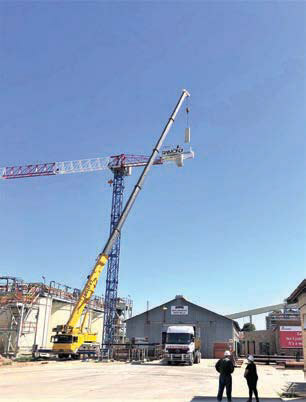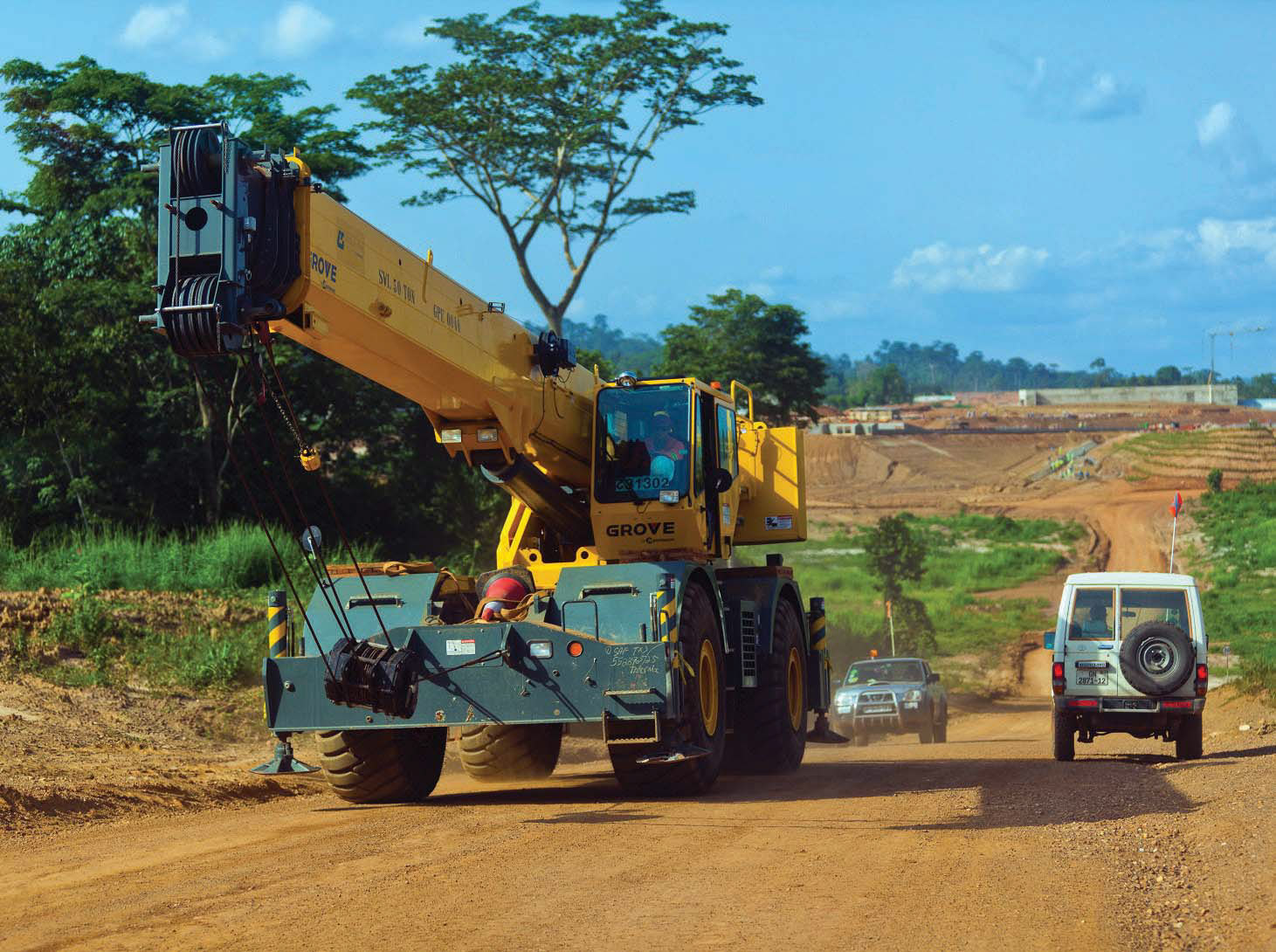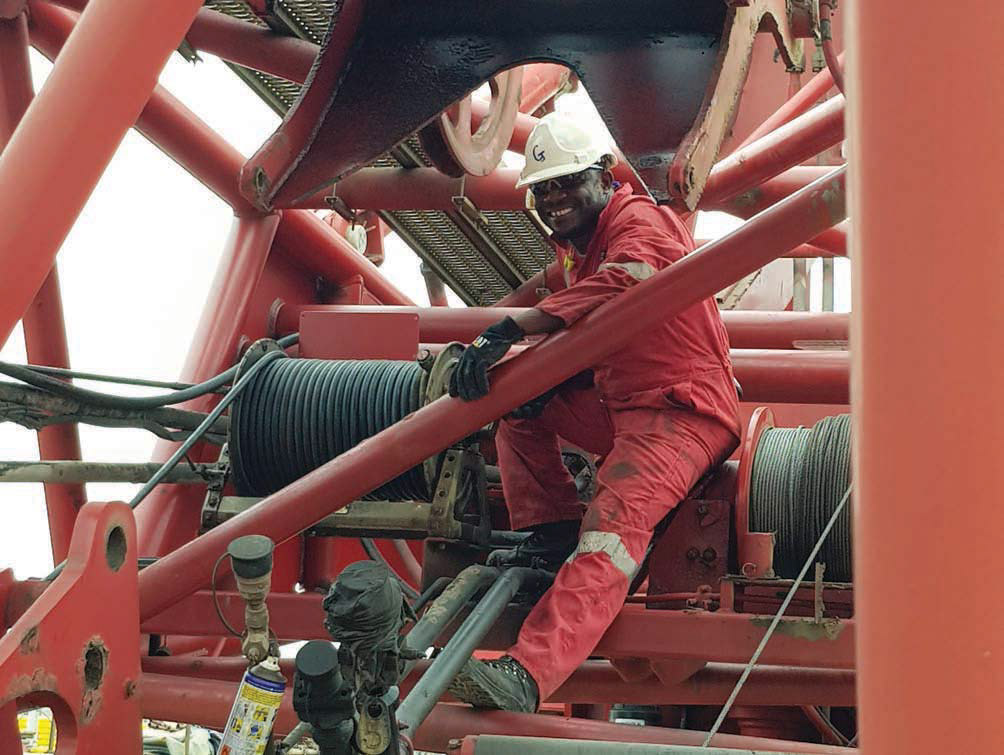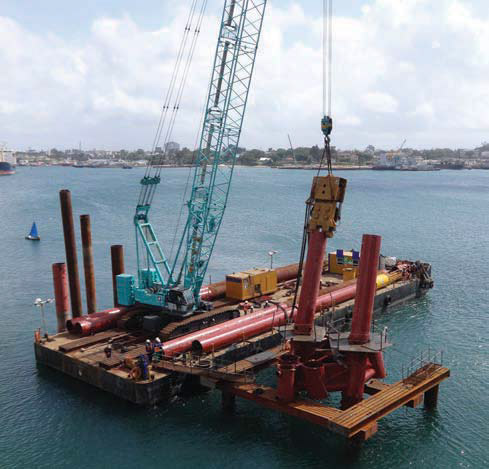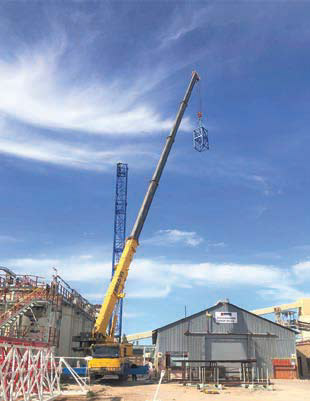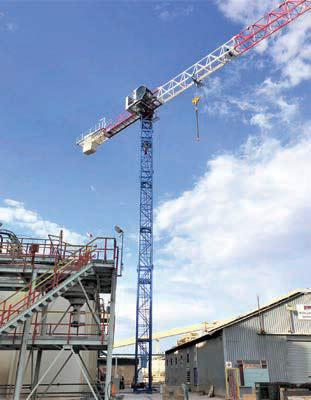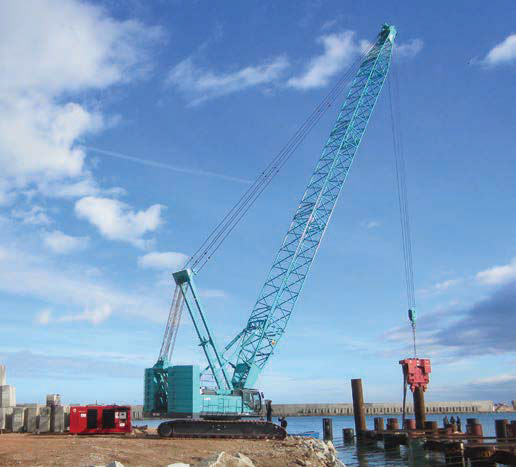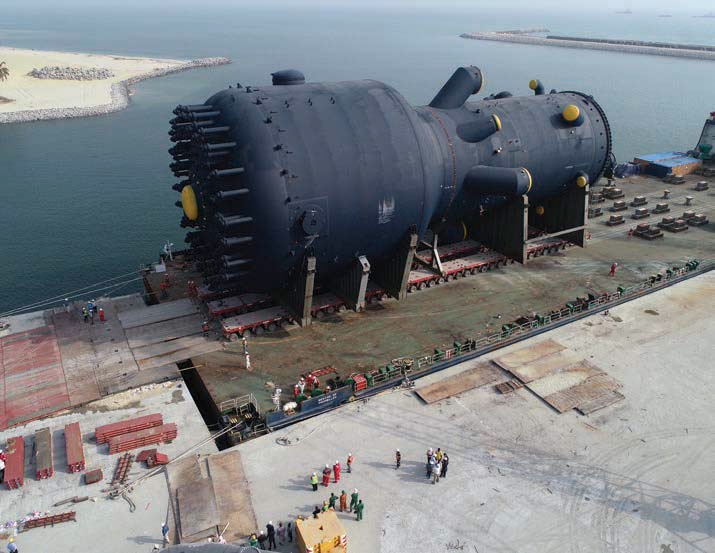Deep mines, tall towers
22 April 2019Shem Oirere reports that a growing economy promises an infrastructure boom in Africa, with mining and general construction also boosting demand for lifting equipment.
Africa's economy grew by 3.7% in 2017, up from 2.3% recorded in the previous year. Analysts have predicted that the rate of growth could have reached 3.8% in 2018, creating a conducive environment for an infrastructure development boom, one of the biggest triggers for an increased uptake of lifting equipment in the continent.
Although no precise figures are immediately available on the value of Africa's crane market, demand for the lifting equipment is projected to grow on the back of increasing demand from the many construction and mining projects that have either been completed or currently underway in many parts of the continent.
For developers and contractors in construction, building, and mining industries in West Africa and South Africa, the focus is on how to leverage on the two regions' economic recovery to ensure rapid infrastructure development.
Crane manufacturers and suppliers, buoyed by the demand for lifting equipment, now have an opportunity not only to grow their sales and also demonstrate how modern technology in the manufacture and operation of mobile, tower and marine cranes can effectively address the environmental concerns in Africa.
By June 2018, a survey by multinational professional services provider, Deloitte, indicated there were about 482 construction projects that had broken ground in Africa. Only projects valued at more than $50m qualified for the survey, with Deloitte saying the number of those qualifying had gone up by 59% in 2018.
The projects combined value was estimated at $481bn, an equivalent of 53.3% more than those surveyed in 2017.
Although in West Africa the value of the Deloitte surveyed construction projects decreased by 15.8% to $82.8bn compared to 2017, the total number went up in 2018 to 105. The previous year, West Africa's value of construction projects was estimated at $119.8bn driven largely by a boom in the mining and gas sectors, according to Deloitte.
However, the slow economic recovery of West Africa's biggest economy, Nigeria, meant constrained expenditure on big construction projects hence the decrease in new undertakings in the region. The country accounts for nearly 20% of Africa's GDP and about 75% of the West African economy.
Down south in South Africa, there were an estimated 103 construction projects valued at $125.4bn up from $93.4bn and $89.7bn for 2017 and 2016 respectively. The country has the largest share of infrastructure and construction projects in Southern Africa ahead of other major economies such as Angola and Mozambique, according to the Deloitte report.
Some of the large-scale projects in Southern Africa that could be behind the increasing demand for high performing crane models include Lauca electricity generating project, Luanda International Airport, Caculo Cabaca hydropower construction and Kaombo oil block in Angola; Waterfall City Development, Kusile and Medupi power stations in South Africa and Namibie refinery project in Namibia.
Moreover, Nigeria, which has more than 32 projects under various phases of construction or implementation in West Africa remains a key market for crane suppliers as some of the biggest construction projects in the region are underway in the country.
The projects include Olokola Deepsea Port, Dangote Refinery, Eko Atlantis, Onne Port Complex, Lagos-Badagry Expressway expansion, Lekki Deepsea Port and the Lagos-Ibadan Railways modernisation project.
Construction companies based in China, the home of crane manufacturers such as Zoomlion and XCMG, owned 16 large-scale construction projects in sub Saharan Africa according to the survey by Deloitte, which is an equivalent of 3.3% of all the projects under construction by June 2018. The Chinese firms also topped the list of construction project developers in Africa during the period taking up 33.2% of all the projects.
“What makes the Africa market exciting is that the continent's economies are not growing at the same pace. While others are growing faster, others are a bit slower,” says Mark Evans, who leads sales for Kobelco Construction Machinery in the UK and Africa. Kobelco manufactures the CKE, BMS, and 7000s series of cranes for these markets.
“Growth is slower in countries where electoral process are ongoing or expected and in Africa elections and associated effects take a little longer compared to Europe or North America,” he says.
“But overall there is economic growth in Africa and this is what drives crane companies such as Kobelco to be active across the continent especially in southern and northern Africa,” adds Evans. Probably driven by the general growth that is being realized in Africa, Evans said Kobelco “is looking to finalise distribution agreements in some countries.”
Kobelco has supplied contractors with cranes for projects in Kenya, Morocco and Algeria.
But the South African market remains one of the largest in Africa driven largely by demand from the country's mining industry, which contributed 7.3% of the country's $349.4bn gross domestic product (GDP).
“South Africa is one of the largest and most developed crane markets in Africa. The market may not have big oil and gas operations but it is strong in mining and construction,” says Paul Rogers, Manitowoc sales director, Africa.
Most of the construction companies find it more convenient to relocate equipment from their existing fleets elsewhere in the world according to John Traynor, managing director at Paterson Simons & Co. (Africa), a UK-based company selling and providing service for cranes, reachstackers, telehandlers and forklifts in West Africa.
“Construction is a sector that is largely based on used equipment coming from outside the region,” he says about West Africa, where Paterson Simons has carried out operations via affiliate companies of CIT Ghana, Paterson Simons Nigeria and Paterson Simons Togo. Paterson Simons, which supplies both new and used crane equipment manufactured by industry names such as Konecranes, Manitowoc, Manitou and JCB, is operating across West Africa's industries of mining, ports and oil & gas, supplying gantry cranes, overhead cranes, forklifts, lift trucks, crawler cranes, reachstackers, all terrain cranes and rough terrain cranes.
In West Africa, Traynor says the mobile cranes market is largely driven by the mining sector, which he says is becoming “increasingly sophisticated in its operations.”
“When a mine moves from exploration to construction phase this was the point at which a construction contractor would often supply used equipment, often old and poorly maintained, from outside the region for their project which ultimately would be left on site for maintaining the mine,” he said.
However, Traynor adds that “there is now a growing realisation that quality lifting equipment with good local support is needed from the day the mine is completed.” Most of the new crane sales are going into new mines or mine expansion projects, according to Traynor.
In some West African countries, the oil and gas sector is served by a growing number of “quality rental companies who also need new equipment to satisfy demanding safety standards of the industry.”
Africa, like many crane markets in emerging economies, has demand for equipment that is user friendly, consumes less energy, and is cost effective with effective load carrying capacity, says Traynor.
Towards this end, Paterson Simons has recently partnered with PAT Kruger NV to sell, retrofit and service load moment indicators in West Africa.
The company has teamed up with Alimak Hek, Swedish solution provider for rack and pinion personal lifts, focusing on installation and service of ship-toshore cranes in West Africa ports.
It is also working with Konecranes in West Africa focusing their partnership on port and industrial heavy lifting operations.
Under this partnership, Konecranes, has supplied to the West Africa market the Ecolifting solution for lift trucks, which it says include three driveline solutions for lift trucks such as the Power Drive, offering up to 15% fuel savings; Flow Drive, with up to 25% fuel savings; and the pioneering Hybrid Drive, offering up to 40% fuel savings.
Since the solution is available on tier 3 engines “it means it can be available on all machines suitable for West Africa conditions and fuels,” according to Paterson Simons.
Compared to developed markets such as Europe and North America, Africa lags behind in adopting globally accepted crane industry regulations, says Manitowoc's Rogers.
“The African market is often behind the rest of the world markets when it comes to industry regulations with crane manufacturers and suppliers having to adhere to tier 3 or less of fuel regulations,” Roger says.
“In some countries there is only one kind of fuel available and in most cases with high sulphur content and so governments will have to invest more in upgrading of refineries to produce fuel that suits engine models that require low sulphur fuel products.
“Because European engine standards are currently tier 4 or tier 5, some of the crane models we supply in European and North American market may not be suitable for the African market because of the fuel available in this market and this is likely to impact the used cranes market.”
Manitowoc, Rogers adds, is “constantly improving into larger, less costly, less fuel consuming, more efficient and more safe crane products but of course that means our customers will sometimes have to pay a little bit higher for these features.” In fact, to run a modern Tier 4 engine machine you need max 15 ppm ultra low sulphur fuel “which is simply not available,” Traynor says.
Although the UN continues to publish reports and statistics on fuel quality frequently, West Africa continues to be in the list of regions in the world where sulphur limits are in excess of 2000 ppm.
“The tragedy is that much of this fuel has been deliberately blended down by international traders just to make a few extra dollars and although Cote D’Ivoire, Ghana and Nigeria have legislated to introduce a 50 ppm maximum mirroring a move made by countries in East Africa a few years ago, the fuel is still not low enough to run a Tier 4 engine,” says Traynor.
“Practically we have to continue to sell Tier 3 engined machines – and we cannot see this changing in the near future but there is a feeling the trend is going in the right direction."
For markets in the developed world, improving of emissions standards has put limits on the age of used equipment that can be sold outside those areas, Traynor says. For example, machines built after 2012 and sold into Europe and North America cannot be imported into West Africa – reinforcing the two standards and undermining the ability to replace older equipment in West Africa.
“Fortunately Grove have been working with engine manufacturers to develop downgrade kits for Tier 4 to Tier 3 – the process involves some legal documentation as well as physical changes to the engine - and we have now successfully delivered a few recent used units into the area,” he says.
Apart from emissions, crane manufacturers and suppliers are seeking to have in the market equipment that pass the test of simplicity and reliability according to Evans.
He cited the Kobelco crawler cranes, which he said come with “a robust design, simplicity and reliability making it one of the models that is in high demand in the African market especially for operations in remote locations such as Democratic Republic of Congo and Zambia.”
Elsewhere, Manitowoc is optimistic about the performance of the African market, according to Rogers.
“For the next five years, there is a lot more coming up in South Africa, Nigeria, Algeria and other markets in Africa and crane users might put on hold any major decisions until the political and economic situation is clear but obviously the recovery of oil and commodity prices is a good indication the market environment is set to improve and demand for cranes could grow,” he says.
Africa is one of the regions where growth of crane use post 2021 is likely to increase the "market for quality equipment and service is quite small relative to other areas of the world but with a growing acceptance that there is direct relationship between quality and productivity.”
“An increased interest in safety will also drive growth and the quality market will get bigger regardless of how individual markets perform,” adds Traynor.
Moreover, the cranes rental market is likely to remain small despite the presence in the region of active traders and brokers.
“The cranes rental market in South Africa and Africa in general is quite small as most of the project owners and contractors import their equipment,” says Rogers.
However, demand for different crane models and technology is expected to grow in Africa supported by ongoing general modernisation in the continent that is linked to new infrastructure development according to Evans.
“There is also substantial external investment in Africa especially in the abundance and cheap exploitation of raw materials such as minerals, oil and gas that is needed to support industrial operations in the rest of the world where the availability of similar commodities are diminishing,” he says.
Crane manufacturers with operations in Africa, or those that supply infrastructure developers in the continent are helping the private and public sector address the issue of the lack of skilled manpower in operating cranes, which is a major constraint to growth of the region's crane market.
Demand for skilled technicians to assemble, dismantle and operate different crane models has been on the rise in tandem with the rising number of cranes supplied to Africa.
“Every crane that we deliver to any market in Africa we ensure we work with the customer and take them through the assembling, operating and maintenance of the equipment and we constantly provide training for the contractor's rigging crews. Kobelco provides global service to all its clients 364 days a year,” says Evans.
Manitowoc's Rogers says: “in every crane supply contract our company includes a training package where we ensure a technician is attached to ensure proper deployment of the equipment and servicing and maintenance.
"We also have training opportunities in Germany, Italy and the US where we invite some of our customers for higher level courses.
“Project owners invest a lot more in acquiring cranes, maybe $1m or more and therefore it is important that intelligent crane operators are recruited to operate the equipment."
At Paterson Simons, the company has invested in building of a pool of local engineers, which Traynor says “is a long game starting at apprentice level – our only regret is that we cannot bring them through faster: training needs to work hand in hand with experience.”
“One of my proudest achievements in business was seeing two of our local engineers reach Grove Master Technician level and we have more in on the way too,” Traynor adds.
“As Manitowoc dealers we provide on site operator familiarisation as part of the commissioning process for all equipment but we have long taken the view that given the investments made by our customers, particularly those for whom lifting is not a core activity, we need to do much more than that so we have a training division.
“For operators, rigger and lifting supervisors we can provide anything from hands on one on one operator training for an unskilled operator to certified classroom training for seasoned lifting professionals and we even run courses for managers or supervisors who need educating on basic lifting practices to help them understand their relationship with their lifting teams."
In the near future, Africa's crane market will be driven by the increasing demand for construction equipment in the continent's construction industry and also in the region's fast expanding mining industry.
Going for gold
ZLT Tower Cranes, founded by Rob Cook and Mark Bates, was recently appointed as the official agent representing Raimondi Cranes across eight African countries from its base in Midrand, Johannesburg.
ZLT Cranes will act as the sole Raimondi dealer across South Africa, Botswana, Zambia, Namibia, Mauritius, Mozambique, Zimbabwe, and the Democratic Republic of Congo, presenting the manufacturer’s luffing and topless tower cranes as well as its crane accessories.
The company's first sale was of an MRT159 flat-top tower crane to Harmony Gold, who will be using the MRT159 at the Great Noligwa Gold Mine at Vaal Reef, situated in the northwestern region of South Africa.
Regenerating development
As the engineered heavy lifting and transport contractor on the Dangote Refi nery construction project, in Nigeria, Mammoet has successfully and safely received and transported the majority of heavy refi nery components for the project. This includes a 3,000t regenerator, which is the heaviest item ever to be transported over a public road in Africa.
Upon completion, the Dangote Refi nery will have the capacity to process 650,000 barrels of crude oil a day. It is expected to have a signifi cant impact on the Nigerian oil and gas industry and the nation’s overall economy, reducing its dependency on the imports of petroleum products and bringing major employment opportunities. Mammoet’s meticulous level of planning and execution, along with the strong support of Nigerian partner Northridge Engineering, have ensured all vital components are delivered to site safely and on schedule.
Mammoet received the cargo at the new Dangote Quay Lekki, which was specifi cally built for the project. The components, ranging in weight and dimensions, were either received from the ship’s hook onto SPMTs or directly loaded off from Ro-Ro vessels. They were then transported over a 10km route. Once on site they were placed into storage on freshly paved Enviro-Mat, Mammoet’s innovative and sustainable solution for ground reinforcement, which is also being used to provide the main crane hard stands.
The 3,000t regenerator measures 56m long, 23m wide and 25m high. It was offl oaded from the ship using 108 axle lines of SPMT in 3 x 36 lines confi guration and then safely transported to the site. Similarly, a 1,673t reactor, measuring 44m long, 16m wide and 17m high, was transported using 78 axle lines in 3 x 26 lines confi guration.
Lifting and installation of the refi nery equipment was due to commence in late March. To optimize the construction process, Mammoet has drawn on its diverse fl eet of equipment. This includes SPMTs, and mobile and crawler cranes ranging in capacity from 250t to 1,250t. Mammoet will also have its largest super heavy lift ring cranes onsite – the PTC 200 DS and PT 50 – to bring maximum effi ciencies to the execution of the project.
